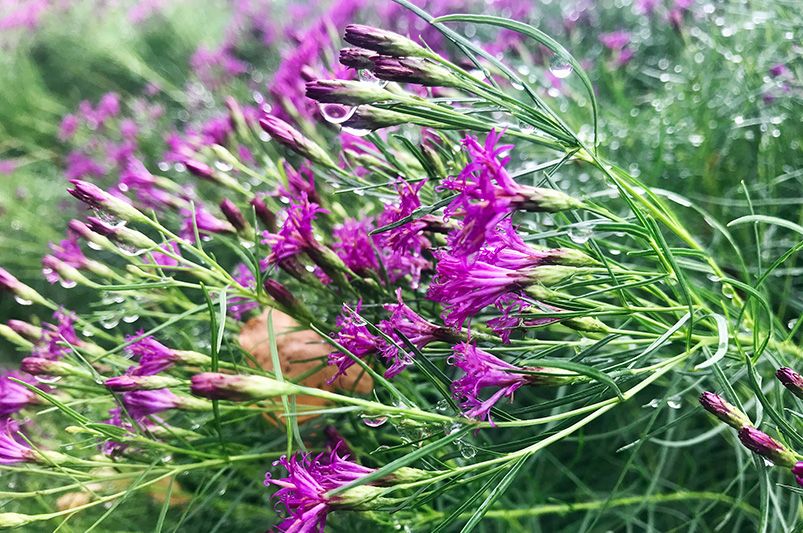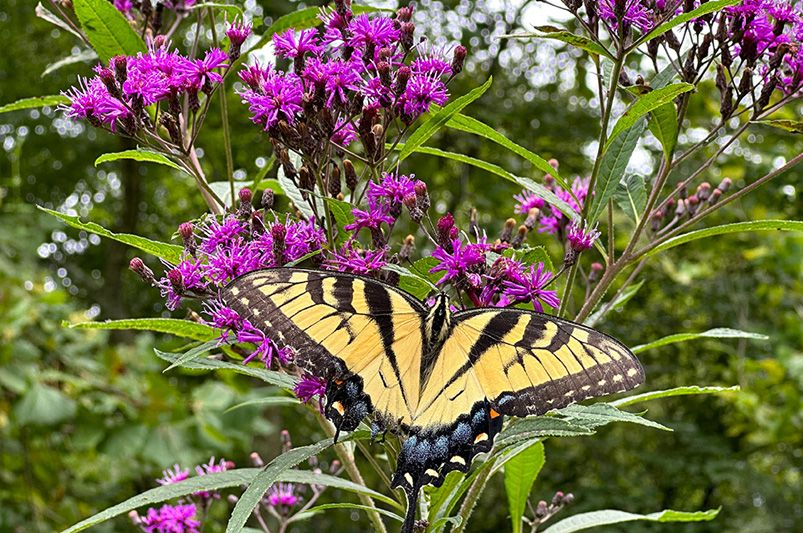
Mighty Blooms: The Unstoppable Force of Iron Butterfly Ironweed
Published: 30/05/2024 | Updated: 30/05/2024
Iron Butterfly Ironweed, Vernonia Lettermannii
When Iron Butterfly Ironweed blooms in late summer, it creates a dramatic sight in the garden, growing to a height of 4 to 6 feet at maturity. This is because towards the end of the growing season, clusters of vivid purple blossoms adorn its tall stalks for at least six weeks. This is a favorite among newbie gardeners because of its hardy characteristics—tough stems, a persistent growth habit, and blooms that eventually give way to rust-colored seed clusters—it’s these attributes that earn the ironweed its name. It’s also a fantastic way to support local wildlife as it acts as a host plant to native bees, flies, skippers, and butterflies including monarchs, swallowtails, and American painted ladies adore the nectar that ironweed supplies along with other pollinators.


Where to Plant Iron Butterfly Ironweed
Low-maintenance Iron Butterfly Ironweed thrives in rich, wet, somewhat acidic soil and full sun. It works best in low locations, sunny, moist beds and borders, especially along stream banks. This perennial grows well in meadows, native prairie gardens, casual cottage gardens, and other naturalised settings. Most grazing animals dislike ironweed’s harsh leaves, so they regard it as a weed in pasture plantings.
When and How to Plant Ironweed
Starting with a plant produced in a nursery is the easiest way to appreciate native plants like ironweed in your yard. After there is no longer a chance of frost, plant it in the spring.
Add organic matter to the soil to prepare the planting area. Plant the seed in a hole that is at least twice as big as the root ball of the plant. Tamp down the original soil and backfill it. Water deeply and frequently until the plant takes root.
Ironweed self-seeds easily and spreads widely. By cutting off the flower heads before the seeds form, you can stop its spread. When completely developed, these are enormous plants. Plant multiples and leave about 2 feet between each one. Cut back juvenile unbranched stems almost to the ground in late spring to reduce the overall height of mature plants.
Tips for Caring for Ironweed
Once established, ironweed requires very little maintenance, much like any other natural plant.
Sunlight Needs
Ironweed thrives in full sun conditions, especially in the northernmost reaches of its hardiness zone. As long as it receives at least 4-6 hours of morning sunshine each day, it can withstand some afternoon shadow in the south.
Watering and Soil Preferences
Although ironweed may grow in most types of soil, it likes slightly acidic, wet, well-drained soil that is rich in humus. The only soil type that will not support ironweed is dry, infertile soil. If the soil is not naturally moist, the plant still requires irrigation even though mulching helps to keep soil moisture. Give it at least one inch of water a week via irrigation or rainfall.
Humidity and Temperature
Ironweed is a natural prairie plant can withstand extreme heat and humidity in its hardiness zones besides being winter-hardy. It needs ground watering to survive during dry spells.
Applying Fertilizer
Ironweed requires little or no additional fertiliser to thrive. You can add compost to the root zone in the spring to give Ironweed a boost.
Trimming
To prevent ironweed from self-seeding, cut off the spent blossoms after it blooms. Additionally, you can gather the blooms for bouquets. Cut the plant back to the ground when the blooming season has ended.
Ironweed: Planting and Potting
For aesthetic reasons, people typically avoid planting ironweed, along with many other tall indigenous plants, in pots. If you decide to grow it in a pot, make sure it has many of the drainage holes and use a heavy-duty pot (ceramic or terracotta) that is designed for wet soils. To keep the soil moist, use potting mix that drains well and water it every day—or twice a day in warmer weather.
It’s time to repot when the plant overcrowds the sides of the pot or grows through the drainage holes. Fill a one-size-larger container with brand-new potting mix. Move the plant, cover it with soil, and give it plenty of water to eliminate any air pockets.
Despite the hardiness of ironweed roots in regions with harsh winters, they remain vulnerable to the cold when planted in pots. Winterize the pots by immersing the container in the earth as a preventative step. You can also transfer the container into an unheated shed or garage, or place it in another, larger pot to form a planting silo that will protect the roots from the cold.
Pests and Diseases
Ironweed is a naturally occurring plant that is immune to most illnesses and pests. Aphids and Japanese beetles occasionally attack the plant. Seldom do deer and rabbits feed on ironweed.

Methods for Growing Ironweed
Division is the simplest way for ironweed to spread. Remove the root and cut it into smaller pieces in the early spring. Once you see new growth, transplant them to other sites at the same depth and give them plenty of water. It is not unusual for the plant to take up to two years to blossom and become established.
Directly sow the seeds in your garden in the autumn to start ironweed from the seed. Once planted, cover and allow them to overwinter at a depth of about 1/8 inch. In the spring, the seeds will sprout. You must stratify your seeds for successful germination when starting them inside. Plant the seeds in small pots with seed-starting mix filled, about four months ahead of the average last frost date in your location. Lightly cover the seeds. Keep the pots covered and chilled for approximately three months. After that, take out the pots and leave them in an open, warm area until the seeds sprout. Till the plants are at least two inches tall, tend to them indoors and keep the soil moist.
You can move plants that are grown from seed or cuttings outside as soon as the soil temperature consistently rises over 65 degrees. Harden off your seedlings by putting them outside for a few hours each day for five to seven days, then accumulating their exposure to the outside each day for a more seamless transition.
Iron Butterfly: Ironweed’s Dainty Variant
Hardy from USDA Zones 4-9., the perennial wildflower Vernonia lettermannii ‘Iron Butterfly’ is a low mounding plant with a narrow, finely textured leaf complemented by a large cluster of pretty pink flowers. Tiny clusters of royal purple disc flowers cover the plants in late summer. Pollinators like as butterflies swarm to the blooms. This plant does best in sunny gardens with average, well-drained soil, or in dry, open woodlands.
The linear blades measure around 3" in length and 1/8" in width. The entire leaf has sharp points. They abundantly generate, giving the plant a pleasantly delicate texture and a velvety look.
Like the New York ironweed, this variety produces large quantities of tiny clusters of unusually brilliant purple flowers from late summer to October. Every floret develops into a brown to grey nutlet with a bristly pappus that ranges in colour from purple to brown. The plants have a robust taproot that firmly anchors them. They are 2-3 feet tall with an equal spread.
When in flower or just in leaf, add a striking accent to a wildlife garden or meadow. When paired with natural grasses and golden autumn blossoms, plants look beautiful. One can employ plants as mass plantings or groupings to produce showy blooms and attractive foliage or as butterfly nectar plants. Uses for this cultivar include Rain Gardens, Low Maintenance Plantings, Cottage Gardens, Deer Resistant Gardens, and Perennial Borders.
Wrapping Up: Ironweed’s Garden Magic
Those deep purple blooms not only catch the eye but also provide a vital haven for local wildlife, enriching the natural tapestry of our gardens. But here’s the thing: crafting a garden that truly celebrates plants like the ironweed takes some know-how. That’s where a trusted partner like Shrubhub steps in. We specialize in creating outdoor spaces where native flora thrives in harmony, and the ironweed is no exception. With our expertise, we weave these stunning plants into our designs to create not just a garden, but a living ecosystem. So, if you’re dreaming of a garden that’s as vibrant as it is sustainable, maybe it’s time to consider Shrubhub as your partner in green.


